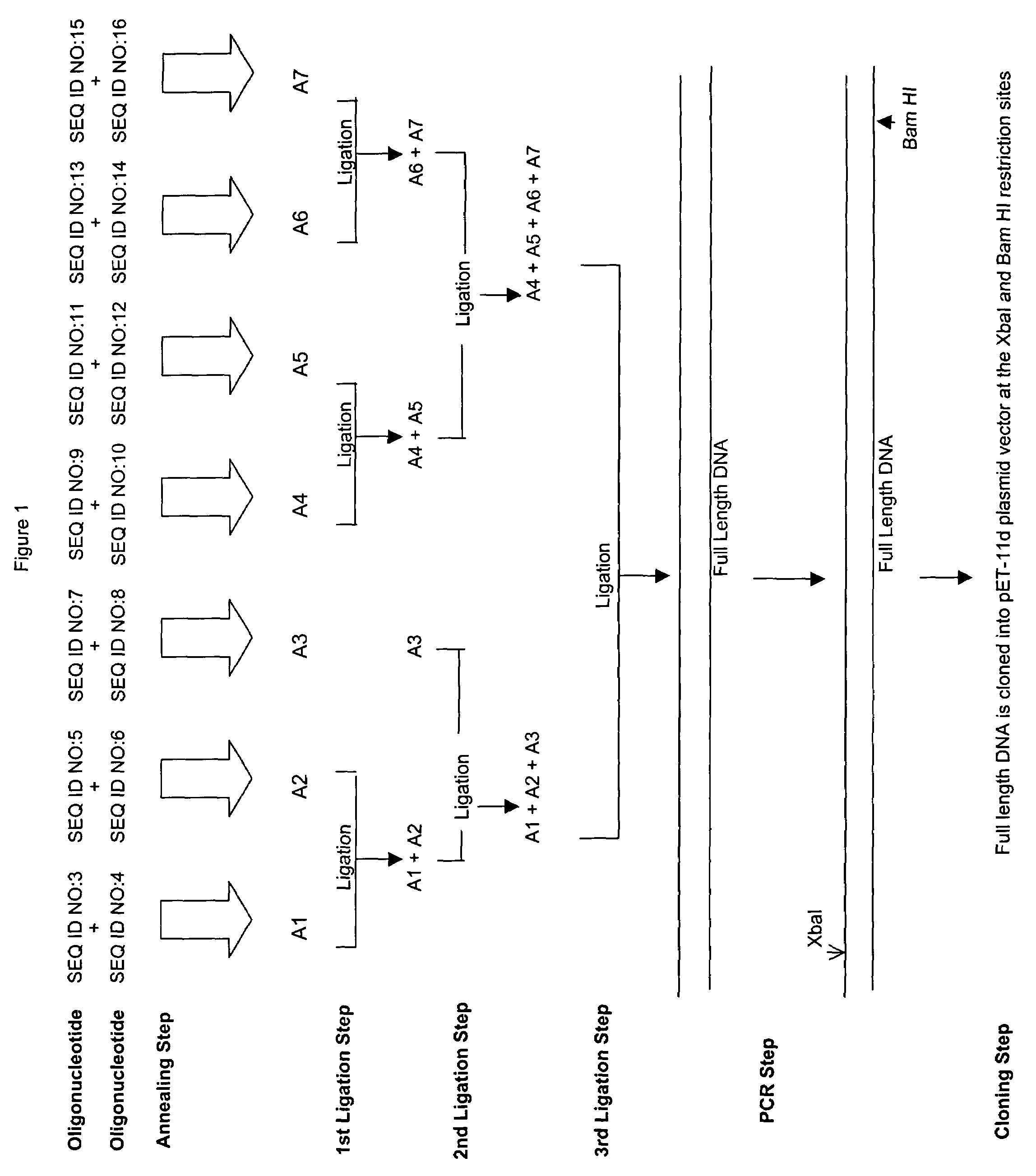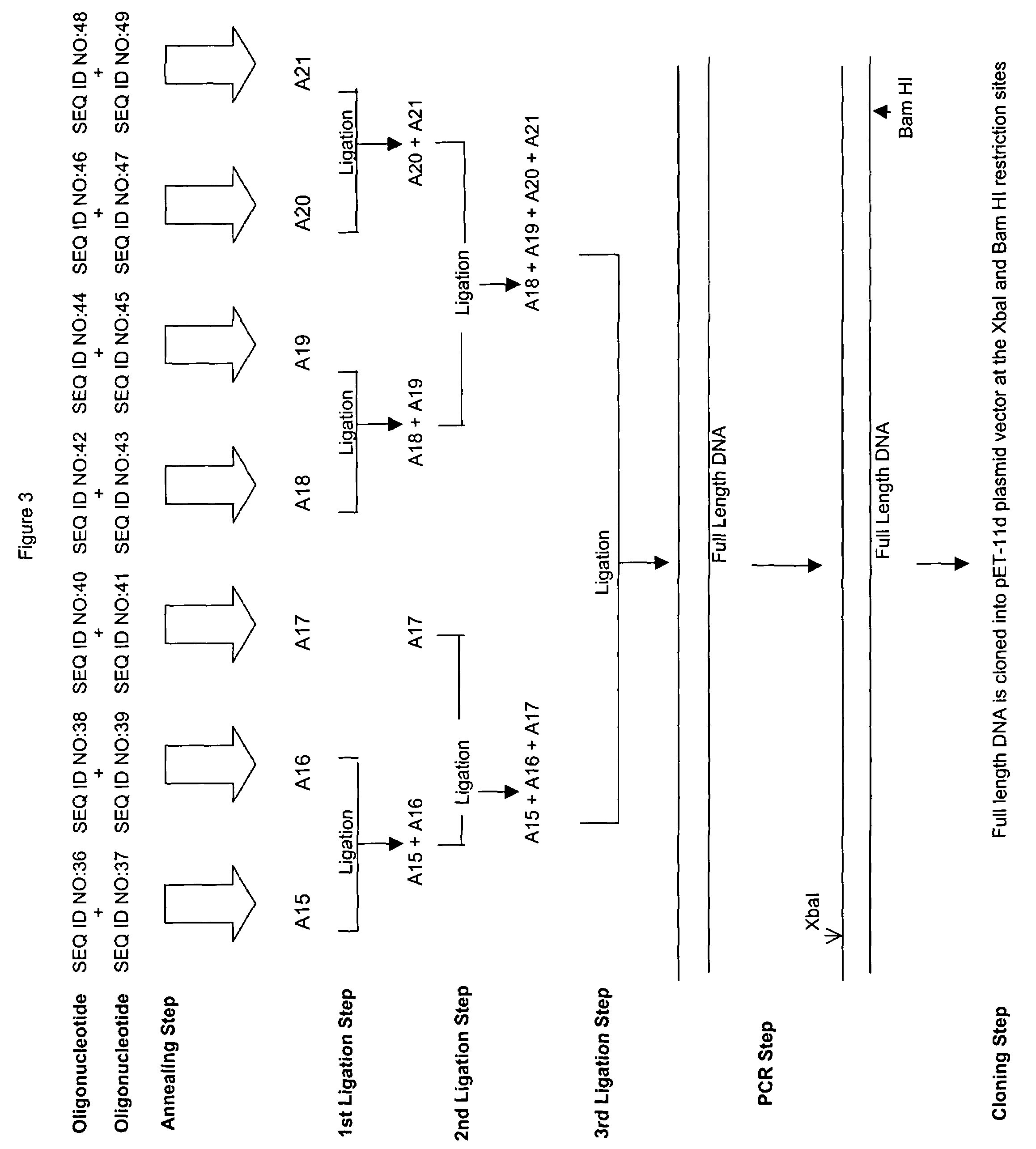Ribonucleases and methods of making them recombinantly
a ribonuclease and recombinant technology, applied in the field of bioactive ribonucleases and tumor treatment drugs in humans, can solve the problems of difficult to obtain regulatory approval for a conjugate and inability to create a fusion protein
- Summary
- Abstract
- Description
- Claims
- Application Information
AI Technical Summary
Problems solved by technology
Method used
Image
Examples
example 1
Synthesis, Cloning, and Expression of pET11d-2325p4 Plasmid DNA
[0037]Example 1 relates to a protein identified as 2325p4 in U.S. Pat. No. 6,239,257 B1, which has the amino acid sequence of SEQ ID NO:1 and the nucleotide sequence of SEQ ID NO:2.
[0038]In an initial step, oligonucleotides SEQ ID NO:3, SEQ ID NO:4, SEQ ID NO:5, SEQ ID NO:6, SEQ ID NO:7, SEQ ID NO:8, SEQ ID NO:9, SEQ ID NO:10, SEQ ID NO:11, SEQ ID NO:12, SEQ ID NO:13, SEQ ID NO:14, SEQ ID NO:15, and SEQ ID NO:16 were synthesized and purified as discussed above.
[0039]In the next step (shown at the top of FIG. 1 and described in detail above), pairs of oligonucleotides were mixed and annealed to form duplex oligonucleotides A1, A2, A3, A4, A5, A6, and A7.
[0040]These annealed oligonucleotides A1, A2, A3, A4, A5, A6, and A7 were then agarose gel purified as discussed above. The annealed and purified oligonucleotides were then mixed and ligated together in three separate ligation steps shown in the center of FIG. 1 using the ...
example 2
Synthesis, Cloning, and Expression of pET11d-2325p6 Plasmid DNA
[0046]Example 2 relates to a protein identified as 2325p6 in U.S. Pat. No. 6,239,257 B1, which has the amino acid sequence of SEQ ID NO:17 and the nucleotide sequence of SEQ ID NO:18.
[0047]In an initial step, oligonucleotides SEQ ID NO:19, SEQ ID NO:20, SEQ ID NO:21, SEQ ID NO:22, SEQ ID NO:23, SEQ ID NO:24, SEQ ID NO:25, SEQ ID NO:26, SEQ ID NO:27, SEQ ID NO:28, SEQ ID NO:29, SEQ ID NO:30, SEQ ID NO:31, and SEQ ID NO:32 were synthesized and purified as discussed above.
[0048]In the next step (shown at the top of FIG. 2 and described in detail above), pairs of oligonucleotides were mixed and annealed to form duplex oligonucleotides A8, A9, A10, A11, A12, A13, and A14.
[0049]These annealed oligonucleotides A8, A9, A10, A11, A12, A13, and A14 were agarose gel purified as discussed above. The annealed oligonucleotides were mixed and ligated together in three separate ligation steps shown in the center of FIG. 2 using the proc...
example 3
Synthesis, Cloning, and Expression of pET11d-2728 Plasmid DNA
[0055]Example 3 relates to a protein identified as 2728 in U.S. Pat. No. 6,239,257 B1, which has the amino acid sequence of SEQ ID NO:34 and the nucleotide sequence of SEQ ID NO:35.
[0056]In an initial step, oligonucleotides SEQ ID NO:36, SEQ ID NO:37, SEQ ID NO:38, SEQ ID NO:39, SEQ ID NO:40, SEQ ID NO:41, SEQ ID NO:42, SEQ ID NO:43, SEQ ID NO:44, SEQ ID NO:45, SEQ ID NO:46, SEQ ID NO:47, SEQ ID NO:48, and SEQ ID NO:49 were synthesized and purified as discussed above.
[0057]In the next step (shown at the top of FIG. 3 and described in detail above), pairs of oligonucleotides were mixed and annealed to form duplex oligonucleotides A15, A16, A17, A18, A19, A20, and A21.
[0058]These annealed oligonucleotides A15, A16, A17, A18, A19, A20, and A21 were agarose gel purified as discussed above. The annealed oligonucleotides were mixed and ligated together in three separate ligation steps shown in the center of FIG. 3 using the proc...
PUM
 Login to View More
Login to View More Abstract
Description
Claims
Application Information
 Login to View More
Login to View More - R&D
- Intellectual Property
- Life Sciences
- Materials
- Tech Scout
- Unparalleled Data Quality
- Higher Quality Content
- 60% Fewer Hallucinations
Browse by: Latest US Patents, China's latest patents, Technical Efficacy Thesaurus, Application Domain, Technology Topic, Popular Technical Reports.
© 2025 PatSnap. All rights reserved.Legal|Privacy policy|Modern Slavery Act Transparency Statement|Sitemap|About US| Contact US: help@patsnap.com



